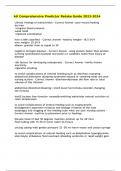SED Task 1 Emotions: bodily symptoms and verbal expressions
Learning goals (A): Learning goals (B):
1. Definitions of simple and complex 1. What is the function of blushing?
emotion 2. How does blushing work
2. Measuring emotions and their physiologically?
advantages and disadvantages 3. What causes blushing?
3. Differences between humans and 4. What is the age trajectory of
animals blushing?
5. Why are people afraid of blushing
Emotions
1. Simple and complex emotion
From basic emotions to a wide range of emotions at 3y (almost adult-like). Emotions and
their development are tied to cognitive development (consciousness). The emergence of self-
knowledge alters old emotions and gives rise to new ones. Two types of emotions:
- Basic/primary emotions: most likely present in humans and other animals
- Self-conscious emotions: require elaborate cognitions, including consciousness.
Emerge at about 3 years.
Early or primary emotions
Joy, sadness, disgust, anger, fearfulness and surprise ; Present within first 6m. cognitive
processes that underlie these emotions cosnsist of perceptual abilities, including
discrimination and STM.
At birth the child shows a bipolar emotional life. On the one hand thre is great distress
marked by crying and irritability. On the other hand there is pleasure marked by satisfaction,
attention and responsivity to the environment.
By 3m joy emerges. Infants start to smile and show excitement/happiness when confronted
with familiar or pleasant events and during play. Very early smiling appears to be reflective
in nature. Also sadness emerges, especially around the withdrawal of positive stimulus
events. Also disgust: spitting out and getting rid of unpleasant tasting or smelling objects
placed in the mouth (defensive reflex)
Between 4-6m anger emerges, although it might already be present at 2m. It is manifested
when children are frustrated. Anger is associated with unique cognitive capacities. It is
thought to be a facial and motor/body response set designed to overcome an obstacle. For
anger to be adaptive it has to have a function to overcome a barrier blocking a goal. So the
infant demonstrating anger has to have early knowledge acquisition.
Between 6-8m fearfulness emerges (sometimes earlier), but reaches its peak at 18m, when
measured as fearfulness at the approach of a stranger. Fearfulness reflects further cognitive
development. Infants have to be capable of comparing the event that causes them fearfulness
with some other event. Fearfulness cannot emerge until a comparison ability appears.
Surprise also emerges in the first 6m. they show surprise when there are violations of
expected events or as a response to discovery (aha experience) like new insights.
Self-conscious emotions
Consciousness is acquired in the middle of the second year. Infants of 8-9m show all basic
emotions, but before consciousness emerges they do not experience the state they are in.
Rouge on the nose test, from 15m, max at 24m. with self-recognition, personal pronouns such
as ‘ me’ and ‘mine’, and pretend play emerge. Empathy, jealousy and exposure
Learning goals (A): Learning goals (B):
1. Definitions of simple and complex 1. What is the function of blushing?
emotion 2. How does blushing work
2. Measuring emotions and their physiologically?
advantages and disadvantages 3. What causes blushing?
3. Differences between humans and 4. What is the age trajectory of
animals blushing?
5. Why are people afraid of blushing
Emotions
1. Simple and complex emotion
From basic emotions to a wide range of emotions at 3y (almost adult-like). Emotions and
their development are tied to cognitive development (consciousness). The emergence of self-
knowledge alters old emotions and gives rise to new ones. Two types of emotions:
- Basic/primary emotions: most likely present in humans and other animals
- Self-conscious emotions: require elaborate cognitions, including consciousness.
Emerge at about 3 years.
Early or primary emotions
Joy, sadness, disgust, anger, fearfulness and surprise ; Present within first 6m. cognitive
processes that underlie these emotions cosnsist of perceptual abilities, including
discrimination and STM.
At birth the child shows a bipolar emotional life. On the one hand thre is great distress
marked by crying and irritability. On the other hand there is pleasure marked by satisfaction,
attention and responsivity to the environment.
By 3m joy emerges. Infants start to smile and show excitement/happiness when confronted
with familiar or pleasant events and during play. Very early smiling appears to be reflective
in nature. Also sadness emerges, especially around the withdrawal of positive stimulus
events. Also disgust: spitting out and getting rid of unpleasant tasting or smelling objects
placed in the mouth (defensive reflex)
Between 4-6m anger emerges, although it might already be present at 2m. It is manifested
when children are frustrated. Anger is associated with unique cognitive capacities. It is
thought to be a facial and motor/body response set designed to overcome an obstacle. For
anger to be adaptive it has to have a function to overcome a barrier blocking a goal. So the
infant demonstrating anger has to have early knowledge acquisition.
Between 6-8m fearfulness emerges (sometimes earlier), but reaches its peak at 18m, when
measured as fearfulness at the approach of a stranger. Fearfulness reflects further cognitive
development. Infants have to be capable of comparing the event that causes them fearfulness
with some other event. Fearfulness cannot emerge until a comparison ability appears.
Surprise also emerges in the first 6m. they show surprise when there are violations of
expected events or as a response to discovery (aha experience) like new insights.
Self-conscious emotions
Consciousness is acquired in the middle of the second year. Infants of 8-9m show all basic
emotions, but before consciousness emerges they do not experience the state they are in.
Rouge on the nose test, from 15m, max at 24m. with self-recognition, personal pronouns such
as ‘ me’ and ‘mine’, and pretend play emerge. Empathy, jealousy and exposure











